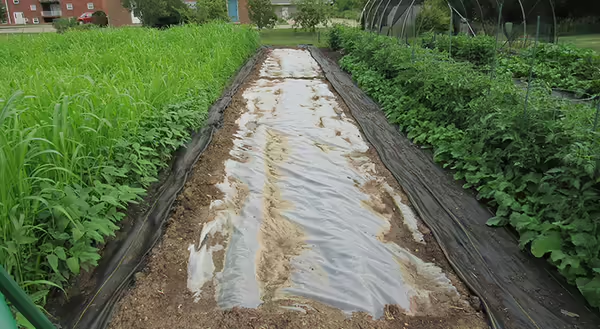
We are testing soil solarization as an effective management strategy for bindweed, a nasty perennial weed, at our Unity site. We know soil solarization can work for control of annual broadleaf and grass weeds, but I have never attempted to control a perennial weed with it. A bindweed-infested bed was tilled, irrigated until saturated; clear polyethylene plastic was installed; and edges of plastic were sealed with soil. Plastic will come off August 6 after one month of solarization, and it will be planted with pelletized carrot seed for a fall crop.
Like everybody else, the regional drought streak was finally broken. Between June 15 and July 1, we finally got rain – about 2.1 inches over several events. The Bloomington Regional Airport data reports a total of 2.1 inches of rain in the month of July so far, for a total of more than 4 inches since the publication of the last newsletter. We are still behind our historical rainfall totals for this point in the year, but specialty and field crops in the region have responded well to the precipitation.
Tomatoes and peppers at the Unity Community Center Food Production and Demonstration Garden are finally experiencing more rapid growth. Warm weather crops such as these are about 10 days behind, on-average. Typical date for first Central Illinois-grown high-tunnel tomatoes to reach market tables and store shelves is the end of the first week of July. By July 15, most local farmers only had cherry tomatoes.
Black currants, the most prolific berry species at the Refuge Food Forest in Normal, put on a just-below-normal crop load, even after an incredibly dry spring. However, they are two full weeks early to maturity. So even though the crop load was relatively unaffected, the timing was likely due to drought.
First harvests of eggplant, tomatillo, and bell pepper occurred at the end of last week. Just like everyone else, we were plagued by heavy wildfire haze in the middle and end of June, and now Central Illinois is getting another round. Because the eggplant, tomatillo, bell pepper, and tomato have all been on drip irrigation since planting on May 25 (and therefore not subject to drought stress), these crops are likely delayed due to the haze interacting with the crops’ ability to receive sunlight.
The ginger trial is going well. The ginger crop appears to be growing slowly but surely, possibly due to lack of consistently sunny and clear skies. Nobody can argue that it has been a strange weather year so far.
Author: Nick Frillman, local food systems and small farms educator based in central Illinois. A fourth-generation graduate from University of Illinois, Nick earned a bachelor of arts degree with a double major in political science and Spanish. He holds a Master of Science degree in crop science, with a focus in crop production. Frillman gained additional on-farm experience as a vegetable apprentice on a small family farm near Sandy, Oregon. He is versed in community supported agriculture (CSA) and farmers markets operations from the perspective of a small farm operator.